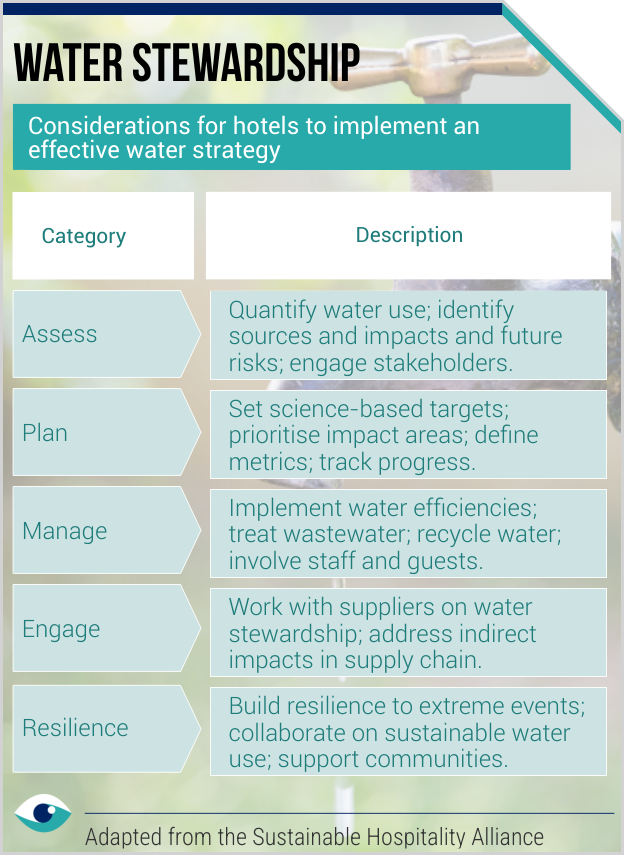Water scarcity increasingly impacts the hotels and lodging industry due to growing demand and declining water supply in quality and quantity. In 2024, BOKU University in Vienna and the Municipal Government of Malaga released "Water Management in Tourism," highlighting escalating global water scarcity pressures. Water risks present uncertainties for the hotel & lodging industry, as drought impacts are indirect and cascading, depending on social, economic, regional and climatological contexts. Therefore, accommodation providers should conduct water risk assessments and implement water-saving measures to mitigate impacts of water scarcity and stress.

BACK

Proactive water risk management essential for hotels
Hotels urged to address water scarcity through proactive risk assessments and sustainable land use changes for long-term viability
Planet: Environmental impacts
Hotels & lodging
AT A GLANCE
Water scarcity is a significant risk for hotels, necessitating proactive assessments and water-saving measures.
This is vital as the global water crisis ranks among top five global risks, with hotels facing indirect impacts complicating policies.
Major hotel chains are implementing comprehensive water management strategies with measurable targets for 2025-2030.
Impact of water scarcity
Water scarcity and drought are top global risks for hotel operations. The crisis ranks among the top five risks to humanity, highlighting its urgency for hospitality. Hotels in drought-prone areas face cascading effects that complicate preparedness due to water shortages and rising climate threats. Accor found ~10% of its hotels face a 1–10% flood risk in a 4°C scenario from rising water levels, river overflows, or heavy rain. These physical climate risks raise insurance costs, shift valuations, and heighten investor and lender focus on sustainability.
Proactive water management
Hotels must move to proactive water risk management using climate adaptation and risk assessments. The “three pillars” approach—monitoring, vulnerability assessment, and mitigation—supports integrated drought management. Disaster Risk Reduction (DRR) strengthens preparedness and infrastructure. IHG completed a major water risk assessment, mapping all open and most pipeline hotels for water quantity and quality risks. Hilton's 2025 Water Stewardship strategy is working towards community improvements in high-risk areas.

Global South water risks
H World Group addresses water risks during construction and operations. Roofs get water-resistant coatings, and contingency plans cover typhoons, rainstorms, and blizzards to protect customers. The Destination Water Risk Index identifies 12 high-risk locations across six countries based on water stress, cost increases, usage per room, hotel supply, and pipeline growth.

Managing risks proactively
Proactive water management ensures supply and supports long-term resilience. Key tools include climate risk assessments and stress testing. Choice Hotels is overhauling its Room to be Green certification. A fourth certification level will add standards for renewables, grey water and smart tech. The sector is aligning with IFRS to define sustainability metrics with the same rigour as financial reporting. With global water bills soaring—highlighted in the 2024 Water Tariff Survey—water risk is now a financial and strategic concern for hotels.
FURTHER READING
- Water Management in Tourism ( BOKU University - 2024 )
- Water and Tourism: Challenges and Opportunities ( UNWTO - 2023 )
- How the hotel sector is bridging the sustainability and financial reporting gap ( Hospitality Investor )

BACK
